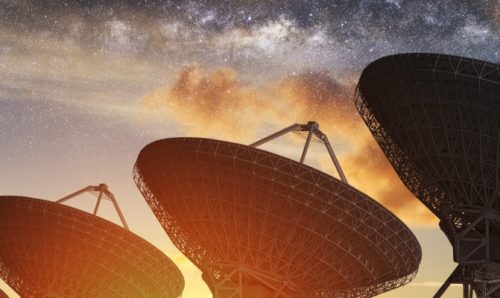The SKA’s the limit: Green light for world’s largest radio telescope network
Our partners Research impact and institutes 15th July 2021
Imagine if we could observe the Universe during its very earliest phases, before – even – the first stars and galaxies were formed.
It might sound far-fetched, but the go-ahead has now been given for the construction of an observatory so powerful, so advanced, that it might just become a reality. And Manchester is playing a crucial part.
The Square Kilometre Array Observatory – often referred to as SKAO or SKA – will be the largest radio telescope network in the world. It will comprise three sites: a low-frequency (50-350 MHz) radio telescope in Western Australia, a mid-frequency (350-15,000 MHz) radio telescope in South Africa, and headquarters, right here, at Jodrell Bank.
We caught up with Professor Michael Garrett, Director of the Jodrell Bank Centre for Astrophysics (JBCA), to learn more about this truly stellar, wondrous project…

Tracing our evolution
“The SKA is the next big step forward for radio astronomy, but with implications for astronomy and astrophysics quite generally, and fundamental physics in particular,” explains Professor Garrett, who is also the inaugural Sir Bernard Lovell Chair of Astrophysics in the Department of Physics and Astronomy.
“As an intergovernmental organisation, similar to CERN, the European Space Agency (ESA) and the European Southern Observatory (ESO), the SKA has special privileges to operate on a global scale. The main scientific goal of the observatory is to observe the Universe during its earliest phases, often referred to as the ‘dark ages’ by astronomers.
“The ambition is for the SKA to trace the evolution of the Universe through the dark ages and on to cosmic dawn, when the first massive stars form from the collapse of huge clouds of primordial hydrogen. Beyond that is ‘cosmic noon’, when the formation rate of black holes, galaxies and stars is at an all-time maximum.
“Through these measurements, our view of the Universe and its rapid evolution is likely to be completely transformed – and, no doubt, many surprises are in store for us!”
A project of such scale and ambition doesn’t happen overnight; in this case it’s been more than 30 years in the making. Once built, the SKA is expected to operate for the next 50 years or more.
Professor Garrett says: “Getting the go-ahead to start construction of the telescopes in South Africa and Australia is a major milestone – it’s a clear demonstration that governments are committed to the project, and have confidence in observatory staff and management, the telescope design, costs, and associated construction plans/procurement process – with construction commencing later this year, both telescopes should be fully operational by the start of the next decade.
“For a telescope that first emerged as a concept in the early 1990s it has been a long road, but the end is now in sight.”
Location and scale
What, though, is so special – so unique – about the SKA?
According to Professor Garrett, there are several features that set it apart. The first is location. Both sites, in Western Australia and the Karoo desert in South Africa, are largely free of human-made radio interference.
They’re both strategically placed far away from centres of population and – incredibly – the site in Australia is so vast that it’s approximately the size of the Netherlands, but with only around 100 people living there.
Both are also in southern hemisphere locations. This means the telescopes will have a fantastic view of the centre of our own Galaxy, the Milky Way, where lots of activity is currently happening – not least the presence of a supermassive black hole, right at the galactic centre.
The second distinctive feature of the SKA is scale. Comprising hundreds of thousands of antennas and hundreds of dishes, the telescopes are both highly sensitive and capable of making high-fidelity images of stars and galaxies – doing so with only a few minutes’ observing time. The antennas and dishes are also distributed across telescope sites on scales up to 150 km, allowing them to survey vast swathes of sky with good sensitivity and excellent spatial resolution, covering frequencies from 50 MHz to 15 GHz.
The result? Astronomers will be able to detect much fainter stars and galaxies than ever before.

Is there anybody out there?
“In my own favourite area of research, SETI (the Search for Extraterrestrial Intelligence),” continues Professor Garrett, “the SKA will be so sensitive that it will be capable of detecting the kind of artificial radio communication and radar signals humankind routinely produces from thousands of stars in the solar neighbourhood.
“The SKA is all about addressing the big questions: Are we alone? When did the first large structures emerge in the early Universe? When and where did the first stars and galaxies form? How did they evolve into the Universe we see around us now?
“How did magnetism arise and what role does it play in the formation of stars, galaxies and planets? What is the basic nature of the dark energy and dark matter that currently dominates the energy budget of the Universe? Does Einstein’s description of gravity (general relativity) continue to apply in the most extreme conditions?
“The list of questions the SKA can address is impressive and long – but the serendipitous discoveries it will make will probably be even more interesting than the questions we can already pose.”
Jodrell’s contribution
All of which brings us back round to Manchester. Just what will our role be?
The answer, according to Professor Garrett, is a very significant one – from the very beginning, through to today, and far into the future.
In fact, astronomers at Jodrell Bank were the first to come up with the basic SKA telescope concept. Professor Peter Wilkinson calculated, back in the early 90s, that detecting hydrogen gas in the most distant galaxies would require a telescope with a collecting area of one square kilometre.
“Since then”, Professor Garrett explains, “other JBCA scientists and engineers have taken up the mantle, making enormous contributions to the detailed technical concept.
“For example, Professor Keith Grainge has been leading the international consortium that has designed the data network and timing system that will transfer telescope data at terabit-per-second rates and picosecond precision to central supercomputing centres, which will process the data.
“Professor Benjamin Stappers has been leading the non-imaging detection system that will be crucial for the detection of transient phenomena (like pulsars, rapidly merging neutron stars and black holes), and Professor Anna Scaife is one of the foremost experts on handling and scientifically exploiting the huge data flows the SKA supercomputers will generate.”

Watch this space
And… what of the future?
“As one of the largest astrophysics groups in Europe, JBCA astronomers are interested in all aspects of the SKA science delivery – from the cosmological studies of the early and distant Universe, to radio emission from the Sun, planets and, indeed, nearby extrasolar giant planets,” Professor Garrett continues.
“That lies in the future, but in the short-term we will be playing a key role in ensuring industry delivers major hardware components for the SKA based on our technical design and checking that they meet our specifications.
“We will also continue to operate and exploit the e-MERLIN array also based at Jodrell Bank – as a recognised SKA pathfinder telescope and as the UK’s national radio astronomy facility, e-MERLIN gives us a head start on the kind of data SKA will deliver ten years from now.”
The SKA will generate enormous data sets, and a key challenge will lie in how to scientifically exploit them. SKA partner countries are investing substantially in national data centres, which will also contribute to a regional – and in this case, European – processing capability.
One of JBCA’s ambitions, Professor Garrett adds, is to lead on the support activities that will enable the UK community to fully exploit SKA interferometric data: “JBCA science support staff led by Dr Rob Beswick are uniquely placed to contribute to this, with unrivalled expertise built up via decades of supporting e-MERLIN and hosting the UK’s ALMA Regional Centre node.
“This experience, combined with the expertise Professor Scaife has built up applying artificial intelligence and machine learning techniques to astrophysical data analysis, will be a powerful combination. In short, we’re going to be really busy doing our own science with the SKA, and helping to ensure other UK astronomers can do the same!”
Ready to go
The project is, in many ways, unique. Interestingly, Professor Garrett concludes, it’s also a rare example of a ‘mega-science project’ that was ‘born global’ from the outset, driven by individual scientists as opposed to a concept defined within a large agency, such as the ESA or NASA, or a multinational observatory, such as the ESO.
“It has been very much a ‘bottom-up’ project… whose time has finally come.”
We, for one, can’t wait to see what it achieves – and the role the JBCA will play.
We’ll leave the last word, however, to Professor Garrett: “The SKA promises to transform our understanding of the Universe – the project has been a long time in the making, but it’s finally becoming a reality.”
Words: Joe Shervin
Images: SKAO, Shutterstock, Mark Waugh, The University of Manchester
Be sure to subscribe on our homepage to keep up to date with all the latest posts from The Hub.




